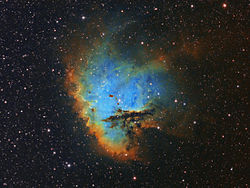Pacman and Friends
More infrared astronomy from WISE. Once again, I've reversed the wavelength order for what I consider a more aesthetically pleasing result, so keep in mind that deep blue is the longer wavelength and red is the shorter wavelength.
The Pacman Nebula, otherwise known as NGC 281, is revealed not as a singular pool of light but as a larger structure of seemingly related knots and trails of dust. Pacman itself is the largest blue structure northeast of center. The two other noticeable structures do not have any special designations.
In the lower right corner of the image is a blueish strand of stars I included because it seemed interesting. Deep blue in this case corresponds to the warm dust in the 22 micron channel. In visible light, a knot of dark, obscuring dust is visible in the location of the strand, but no stars are. If I had to guess I would say they stars in the process of forming. They just happen to be in a line like this instead of clustered into more of a blob. I couldn't find any literature on this particular structure, but star forming regions are ubiquitous throughout the Milky Way. What does seem unusual is their isolation and apparently long, linear shape. I haven't spent nearly enough time studying infrared imagery to say whether it is common or uncommon, though. Is this what a stellar nursery looks like before they begin to blow away their natal dust cloud?
I tried very hard to balance the colors this time and not have the blue and red overwhelm the image, so more cyan is showing through this time, unlike with the Pleiades image. Nine WISE frames were aligned and matched to create a smooth mosaic. Some small optical artifacts were removed. No sharpening or color saturation was done.
Red: W1 (3.4 μm) Yellow-Green: W2 (4.6 μm) Cyan: W3 (12 μm) Blue: W4 (22 μm)
North is up.Relevante Bilder
Relevante Artikel
NGC 281NGC 281 ist ein Emissionsnebel im Sternbild Kassiopeia am Nordsternhimmel, der 9500 Lichtjahre von der Erde entfernt ist. Der Nebel ist im Index-Katalog als IC 11 erfasst und wird umgangssprachlich wegen seiner Ähnlichkeit mit der bekannten gleichnamigen Videospiel-Hauptfigur vor allem im englischen Sprachraum auch als Pac-Man-Nebel bezeichnet. In NGC 281 ist der offene Sternhaufen IC 1590 eingebettet, dessen Sterne um das Zentrum des Nebels verstreut sind und von denen einige durch ihre Röntgenstrahlung hervortreten. Das hellste Mitglied von IC 1590, das Mehrfachsternsystem BD +55° 191 (HD 5005), ist die ionisierende Quelle des Nebels. Der Nebel enthält auch mehrere Bok-Globulen, in denen durch Infrarotaufnahmen Anzeichen für Sternentstehung festgestellt werden konnten. Ebenfalls in Infrarotaufnahmen ist die Molekülwolke erkennbar, deren ionisierter Teil der Emissionsnebel ist. .. weiterlesen



